Water Cleaning by a Continuous Fixed-Bed Column for Cr(VI) Eco-Adsorption with Green Adsorbent-Based Biomass: An Experimental Modeling Study
Abstract
1. Introduction
2. Materials and Methods
2.1. Chemicals
2.2. Preparation of Adsorbent Material
2.3. Characterization of the Biomass Adsorbent
2.4. Continuous Flow Column Studies of Adsorption Experiments
2.5. Fixed-Bed Column Kinetic and Mathematical Modeling
The Bohart-Adams Model
3. Results
3.1. Adsorbent Characterization
3.1.1. Point of Zero Charge (PZC)
3.1.2. Chemical Composition
3.1.3. FTIR Analysis
- (1)
- The stretching vibration of O–H of the functional group of alcohols and carboxylic acids (3408.8 cm−1).
- (2)
- The C–H bending vibration of the stretching vibration CH3 groups (2918.7, 1440.5, and 1373.42 cm−1).
- (3)
- The band at 1739.8 and 1630.9 cm−1 is relative to the C=O stretching of the carboxylic acid with an intermolecular hydrogen bond.
3.1.4. Surface Area and Pore Characteristics
3.1.5. SEM Analysis
3.2. Governing Parameters
3.2.1. Effects of Cr(VI) Concentration
3.2.2. Effects of Bed Height
3.2.3. Effect of the Flow Rate
3.3. The Bohart-Adams Model
3.4. Comparison of Adsorption Capacity with That of Other Absorbents in the Literature
3.5. Cr(VI) Adsorption on RPS Mechanisms
4. Conclusions
- The modeling of the whole breakthrough curves is applied with successful with the Bohart–Adams model, indicating that the surface diffusion is the rate-limiting step in the continues adsorption process, and the latter can be used with confidence of the purpose of design; also, it is the most suitable to fit the experimental results.
- The comparison of the adsorption capacity of RPS adsorbent for Cr(VI) with the adsorbents attempted in fixed-bed columns. It may be concluded that the current green adsorbent has a highly comparable adsorption capacity.
- The Cr(VI) adsorption mechanism onto RPS is complex and takes place since it involves several steps, the electrostatic interaction between the adsorbent functional groups and the Cr(VI) ions make up the adsorption mechanism.
- The data in this investigation of red peanut skin for adsorbing Cr(VI) respond perfectly to the requirements of the global sustainable development policy. Namely, affordability and innovation to combat climate change, as stipulated in the Sustainable Development Goals 7 and 9, which target clean and affordable energy and industry, innovation and infrastructure.
Author Contributions
Funding
Data Availability Statement
Acknowledgments
Conflicts of Interest
References
- Zhuang, J.; Li, M.; Pu, Y.; Ragauskas, A.; Yoo, C. Observation of Potential Contaminants in Processed Biomass Using Fourier Transform Infrared Spectroscopy. Appl. Sci. 2020, 10, 4345. [Google Scholar] [CrossRef]
- Yousef, R.; Qiblawey, H.; El-Naas, M.H. Adsorption as a Process for Produced Water Treatment: A Review. Processes 2020, 8, 1657. [Google Scholar] [CrossRef]
- Younas, F.; Mustafa, A.; Farooqi, Z.U.R.; Wang, X.; Younas, S.; Mohy-Ud-Din, W.; Ashir Hameed, M.; Mohsin Abrar, M.; Maitlo, A.A.; Noreen, S.; et al. Current and Emerging Adsorbent Technologies for Wastewater Treatment: Trends, Limitations, and Environmental Implications. Water 2021, 13, 215. [Google Scholar] [CrossRef]
- Yarwood, J.; Douthwaite, R.; Duckett, S. Spectroscopic Properties of Inorganic and Organometallic Compounds: Techniques, Materials and Applications; Royal Society of Chemistry: Cambridge, UK, 2010; Volume 41, ISBN 978-1-84755-047-7. [Google Scholar]
- Yakout, S.M.; Hassan, M.R.; Omar, H.A. Fixed-Bed Column Study for the Removal of Hexavalent Chromium Ions from Aqueous Solutions via Pyrolysis of the Rice Husk. DWT 2019, 170, 128–137. [Google Scholar] [CrossRef]
- Xu, L.; Cui, H.; Zheng, X.; Liang, J.; Xing, X.; Yao, L.; Chen, Z.; Zhou, J. Adsorption of Cu2+ to Biomass Ash and Its Modified Product. Water Sci. Technol. 2018, 2017, 115–125. [Google Scholar] [CrossRef]
- Wu, Y.; Jiang, Y.; Han, D.; Wang, F.; Zhu, J. Speciation of Chromium in Water Using Crosslinked Chitosan-Bound FeC Nanoparticles as Solid-Phase Extractant, and Determination by Flame Atomic Absorption Spectrometry. Microchim. Acta 2007, 159, 333–339. [Google Scholar] [CrossRef]
- Tielong, L.; Bing, G.; Na, Z.; Zhaohui, J.; Xinhua, Q. Hexavalent Chromium Removal from Water Using Chitosan-Fe0 Nanoparticles. J. Phys. Conf. Ser. 2009, 188, 012057. [Google Scholar] [CrossRef]
- Tejada-Tovar, C.; Gonzalez-Delgado, A.D.; Villabona-Ortiz, A. Characterization of Residual Biomasses and Its Application for the Removal of Lead Ions from Aqueous Solution. Appl. Sci. 2019, 9, 4486. [Google Scholar] [CrossRef]
- Sulaymon, A.H.; Abid, B.A.; Al-Najar, J.A. Removal of Lead Copper Chromium and Cobalt Ions onto Granular Activated Carbon in Batch and Fixed-Bed Adsorbers. Chem. Eng. J. 2009, 155, 647–653. [Google Scholar] [CrossRef]
- Suksabye, P.; Thiravetyan, P.; Nakbanpote, W. Column Study of Chromium(VI) Adsorption from Electroplating Industry by Coconut Coir Pith. J. Hazard. Mater. 2008, 160, 56–62. [Google Scholar] [CrossRef]
- Rajesh, N.; Deepthi, B.; Subramaniam, A. Solid Phase Extraction of Chromium(VI) from Aqueous Solutions by Adsorption of Its Ion-Association Complex with Cetyltrimethylammoniumbromide on an Alumina Column. J. Hazard. Mater. 2007, 144, 464–469. [Google Scholar] [CrossRef] [PubMed]
- Padmesh, T.V.N.; Vijayaraghavan, K.; Sekaran, G.; Velan, M. Batch and Column Studies on Biosorption of Acid Dyes on Fresh Water Macro Alga Azolla Filiculoides. J. Hazard. Mater. 2005, 125, 121–129. [Google Scholar] [CrossRef] [PubMed]
- Nag, S.; Bar, N.; Das, S.K. Cr(VI) Removal from Aqueous Solution Using Green Adsorbents in Continuous Bed Column—Statistical and GA-ANN Hybrid Modelling. Chem. Eng. Sci. 2020, 226, 115904. [Google Scholar] [CrossRef]
- Moreno-Benavides, J.A.; Peña-Salamanca, E.J.; Benítez-Campo, N. Reducing Cr6+ in Electroplating Wastewater with Bacillus Cereus Strain BUniv. Science 2019, 24, 73–89. [Google Scholar] [CrossRef]
- Mondal, N.K.; Samanta, A.; Chakraborty, S.; Shaikh, W.A. Enhanced Chromium(VI) Removal Using Banana Peel Dust: Isotherms, Kinetics and Thermodynamics Study. Sustain. Water Resour. Manag. 2018, 4, 489–497. [Google Scholar] [CrossRef]
- Mignardi, S.; Archilletti, L.; Medeghini, L.; De Vito, C. Valorization of Eggshell Biowaste for Sustainable Environmental Remediation. Sci. Rep. 2020, 10, 2436. [Google Scholar] [CrossRef]
- Martínez-Huitle, C.A. Environment-Friendly Electrochemical Processes. Materials 2021, 14, 1548. [Google Scholar] [CrossRef]
- Malkoc, E.; Nuhoglu, Y.; Dundar, M. Adsorption of Chromium(VI) on Pomace—An Olive Oil Industry Waste: Batch and Column Studies. J. Hazard. Mater. 2006, 138, 142–151. [Google Scholar] [CrossRef]
- Mahringer, D.; Polenz, C.; El-Athman, F. Stabilization of Chromium (VI) in the Presence of Iron (II): Method Development and Validation. Water 2020, 12, 924. [Google Scholar] [CrossRef]
- Liu, L.; Cao, L.; Niu, H.; Wang, J. Zinc Metal–Organic Framework Growing on the Surface of Fruit Peels and Its Photocatalytic Activity. ACS Omega 2021, 6, 10187–10195. [Google Scholar] [CrossRef]
- Levason, W.; Reid, G.; Zhang, W. Synthesis, Properties, and Structures of Chromium(VI) and Chromium(V) Complexes with Heterocyclic Nitrogen Ligands: Chromium(VI) and Chromium(V) Complexes with Heterocyclic Nitrogen Ligands. Z. Anorg. Allg. Chem. 2014, 640, 35–39. [Google Scholar] [CrossRef]
- Kumar, P.A.; Chakraborty, S. Fixed-Bed Column Study for Hexavalent Chromium Removal and Recovery by Short-Chain Polyaniline Synthesized on Jute Fiber. J. Hazard. Mater. 2009, 162, 1086–1098. [Google Scholar] [CrossRef] [PubMed]
- Kromah, V.; Zhang, G. Aqueous Adsorption of Heavy Metals on Metal Sulfide Nanomaterials: Synthesis and Application. Water 2021, 13, 1843. [Google Scholar] [CrossRef]
- Korus, A.; Szlęk, A.; Samson, A. Physicochemical Properties of Biochars Prepared from Raw and Acetone-Extracted Pine Wood. Fuel Process. Technol. 2019, 185, 106–116. [Google Scholar] [CrossRef]
- Ko, D.C.K.; Porter, J.F.; McKay, G. Optimised Correlations for the Fixed-Bed Adsorption of Metal Ions on Bone Char. Chem. Eng. Sci. 2000, 55, 5819–5829. [Google Scholar] [CrossRef]
- Kebir, M.; Trari, M.; Maachi, R.; Nasrallah, N.; Bellal, B.; Amrane, A. Relevance of a Hybrid Process Coupling Adsorption and Visible Light Photocatalysis Involving a New Hetero-System CuCo2O4/TiO2 for the Removal of Hexavalent Chromium. J. Environ. Chem. Eng. 2015, 3, 548–559. [Google Scholar] [CrossRef]
- Kebir, M.; Chabani, M.; Nasrallah, N.; Bensmaili, A.; Trari, M. Coupling Adsorption with Photocatalysis Process for the Cr(VI) Removal. Desalination 2011, 270, 166–173. [Google Scholar] [CrossRef]
- Hu, Q.; Pang, S.; Wang, D.; Yang, Y.; Liu, H. Deeper Insights into the Bohart–Adams Model in a Fixed-Bed Column. J. Phys. Chem. B 2021, 125, 8494–8501. [Google Scholar] [CrossRef]
- Gizaw, A.; Zewge, F.; Chebude, Y.; Mekonnen, A.; Tesfaye, M. Simultaneous Nitrate and Phosphate Abatement Using Calcium Silicate Hydrate Adsorbent: Fixed Bed Column Adsorption Study. Surf. Interfaces 2022, 30, 101961. [Google Scholar] [CrossRef]
- Ghosh, P.K. Hexavalent Chromium [Cr(VI)] Removal by Acid Modified Waste Activated Carbons. J. Hazard. Mater. 2009, 171, 116–122. [Google Scholar] [CrossRef]
- Furusho, Y.; Sabarudin, A.; Hakim, L.; Oshita, K.; Oshima, M.; Motomizu, S. Automated Pretreatment System for the Speciation of Cr(III) and Cr(VI) Using Dual Mini-Columns Packed with Newly Synthesized Chitosan Resin and ME-03 Resin. Anal. Sci. 2009, 25, 51–56. [Google Scholar] [CrossRef] [PubMed]
- Fournier, P.; Szczepanski, C.R.; Godeau, R.-P.; Godeau, G. Chitosan Extraction from Goliathus Orientalis Moser, 1909: Characterization and Comparison with Commercially Available Chitosan. Biomimetics 2020, 5, 15. [Google Scholar] [CrossRef] [PubMed]
- Emami Moghaddam, S.A.; Harun, R.; Mokhtar, M.N.; Zakaria, R. Potential of Zeolite and Algae in Biomass Immobilization. BioMed Res. Int. 2018, 15, 6563196. [Google Scholar] [CrossRef]
- da Costa, T.B.; da Silva, T.L.; Costa, C.S.D.; da Silva, M.G.C.; Vieira, M.G.A. Chromium Adsorption Using Sargassum Filipendula Algae Waste from Alginate Extraction: Batch and Fixed-Bed Column Studies. Chem. Eng. J. Adv. 2022, 11, 100341. [Google Scholar] [CrossRef]
- Chu, K.H. Breakthrough Curve Analysis by Simplistic Models of Fixed Bed Adsorption: In Defense of the Century-Old Bohart-Adams Model. Chem. Eng. J. 2020, 380, 122513. [Google Scholar] [CrossRef]
- Chauhan, D.; Sankararamakrishnan, N. Modeling and Evaluation on Removal of Hexavalent Chromium from Aqueous Systems Using Fixed Bed Column. J. Hazard. Mater. 2011, 185, 55–62. [Google Scholar] [CrossRef]
- Charis, G.; Danha, G.; Muzenda, E. Characterizations of Biomasses for Subsequent Thermochemical Conversion: A Comparative Study of Pine Sawdust and Acacia Tortilis. Processes 2020, 8, 546. [Google Scholar] [CrossRef]
- Abidi, M.; Hajjaji, A.; Bouzaza, A.; Trablesi, K.; Makhlouf, H.; Rtimi, S.; Assadi, A.A.; Bessais, B. Simultaneous removal of bacteria and volatile organic compounds on Cu2O-NPs dec-orated TiO2 nanotubes: Competition effect and kinetic studies. J. Photochem. Photobiol. A Chem. 2020, 400, 112722. [Google Scholar] [CrossRef]
- Baaloudj, O.; Nasrallah, N.; Kebir, M.; Khezami, L.; Amrane, A.; Assadi, A.A. A compara-tive study of ceramic nanoparticles synthesized for antibiotic removal: Catalysis charac-terization and photocatalytic performance modeling. Environ. Sci. Pollut. Res. 2021, 28, 13900–13912. [Google Scholar] [CrossRef]
- Assadi, A.A.; Bouzaza, A.; Lemasle, M.; Wolbert, D. Removal of trimethylamine and iso-valeric acid from gas streams in a continuous flow surface discharge plasma reactor. Chem. Eng. Res. Des. 2015, 93, 640–651. [Google Scholar] [CrossRef]
- Azzaz, A.A.; Jellali, S.; Akrout, H.; Assadi, A.A.; Bousselmi, L. Dynamic investigations on cationic dye desorption from chemically modified lignocellulosic material using a low-cost eluent: Dye recovery and anodic oxidation efficiencies of the desorbed solutions. J. Clean. Prod. 2018, 201, 28–38. [Google Scholar] [CrossRef]
- Zeghioud, H.; Assadi, A.A.; Khellaf, N.; Djelal, H.; Amrane, A.; Rtimi, S. Reactive species monitoring and their contribution for removal of textile effluent with photocatalysis under UV and visible lights: Dynamics and mechanism. J. Photochem. Photo-Biol. A Chem. 2018, 365, 94–102. [Google Scholar] [CrossRef]
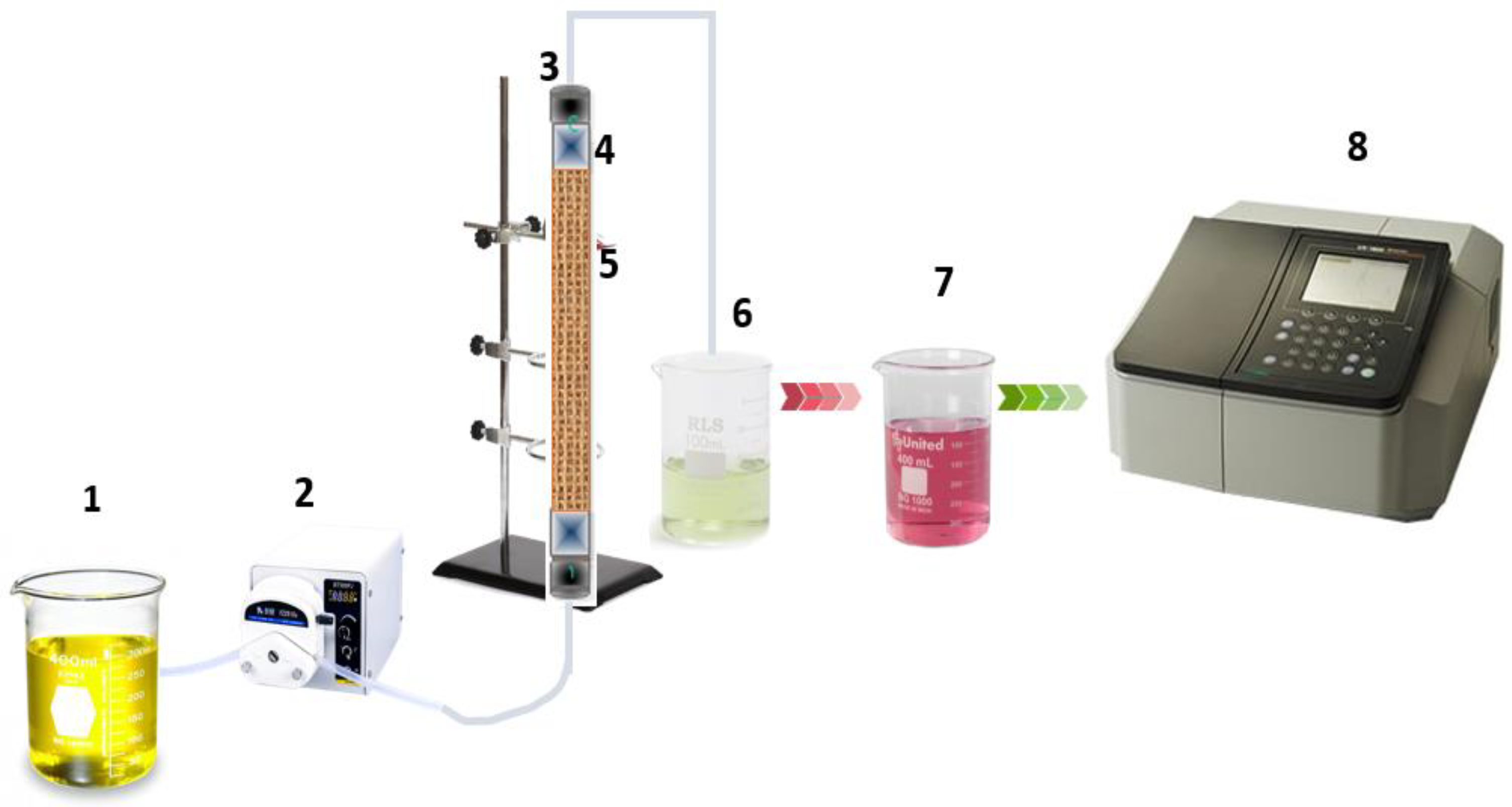
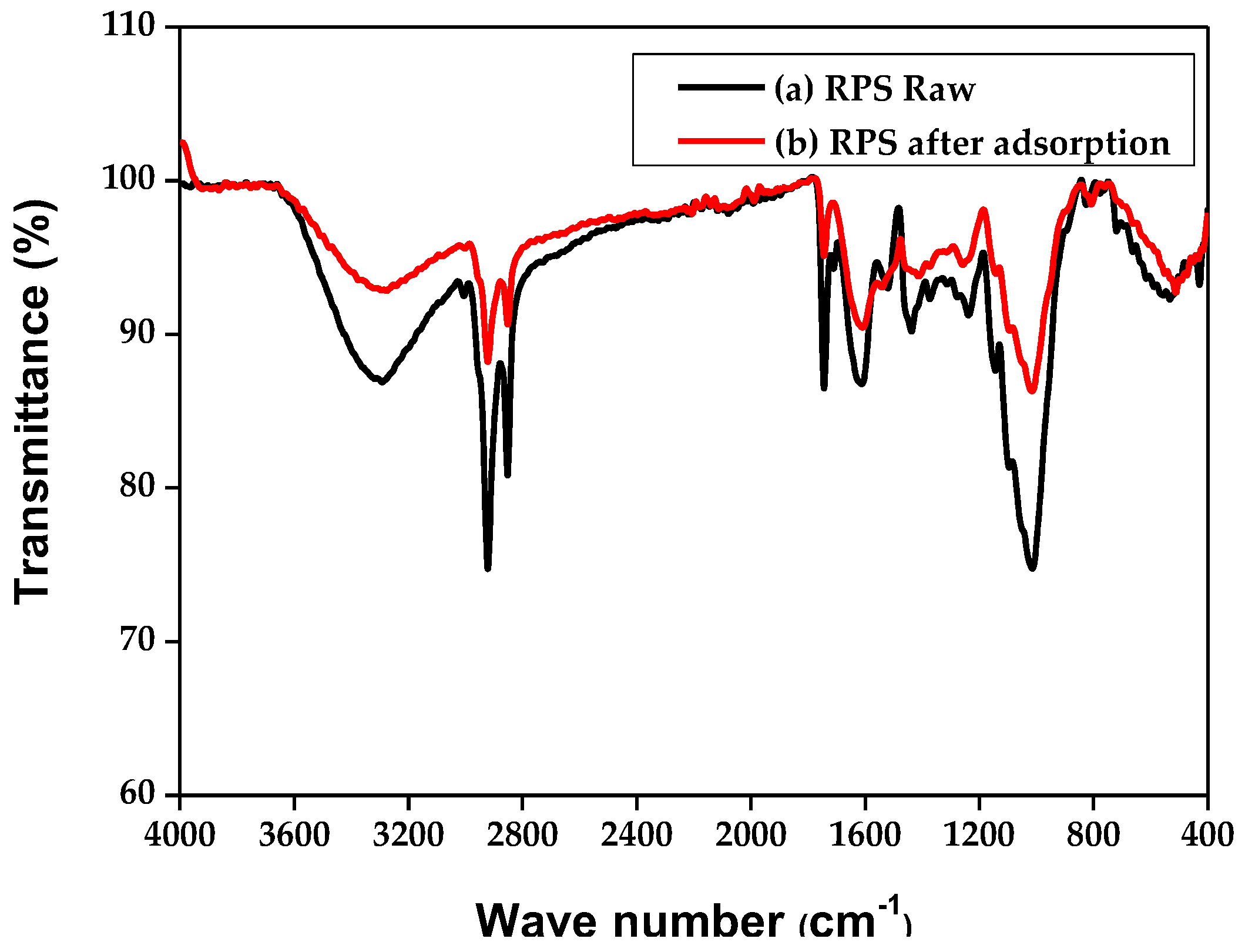

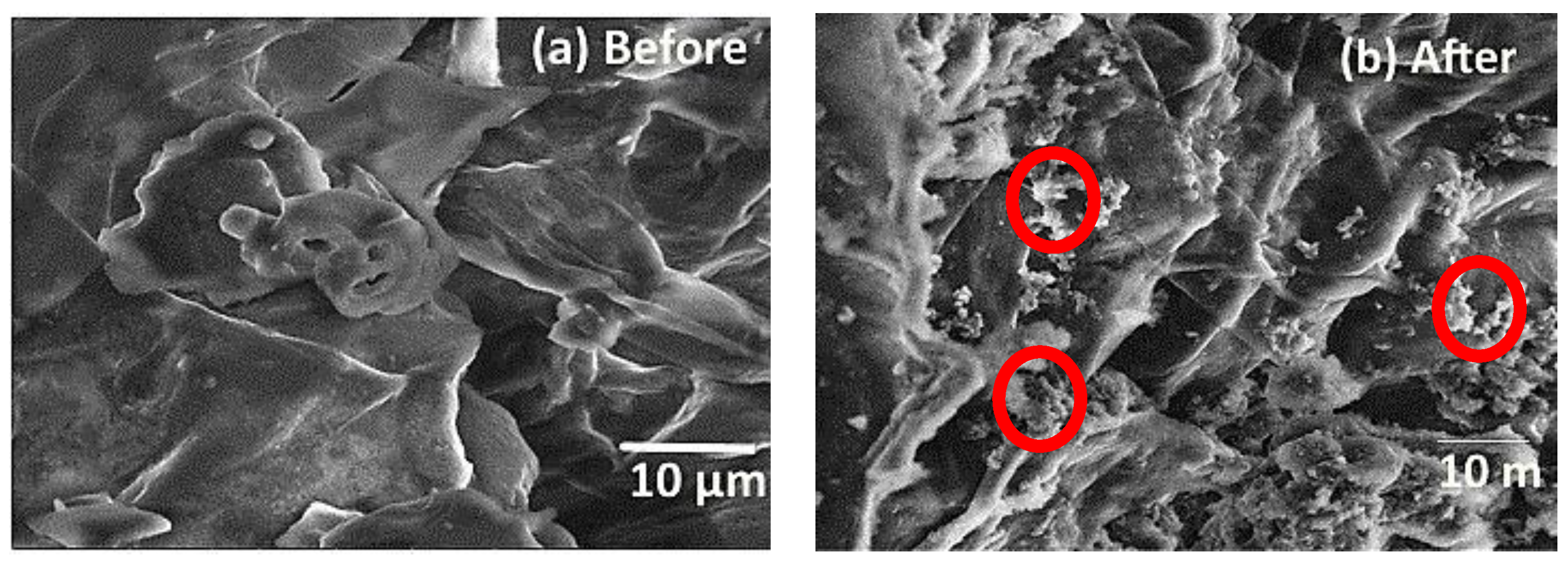
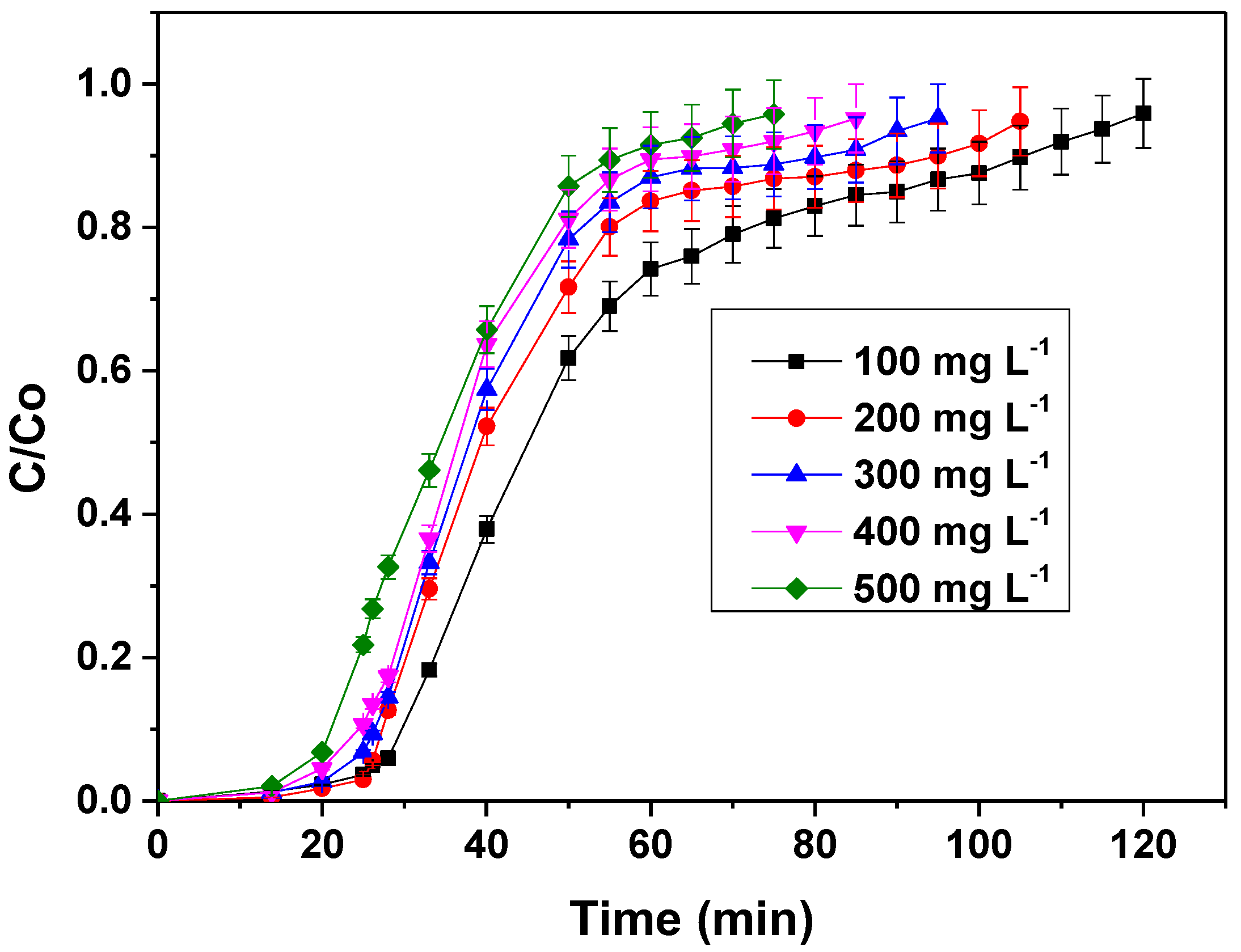

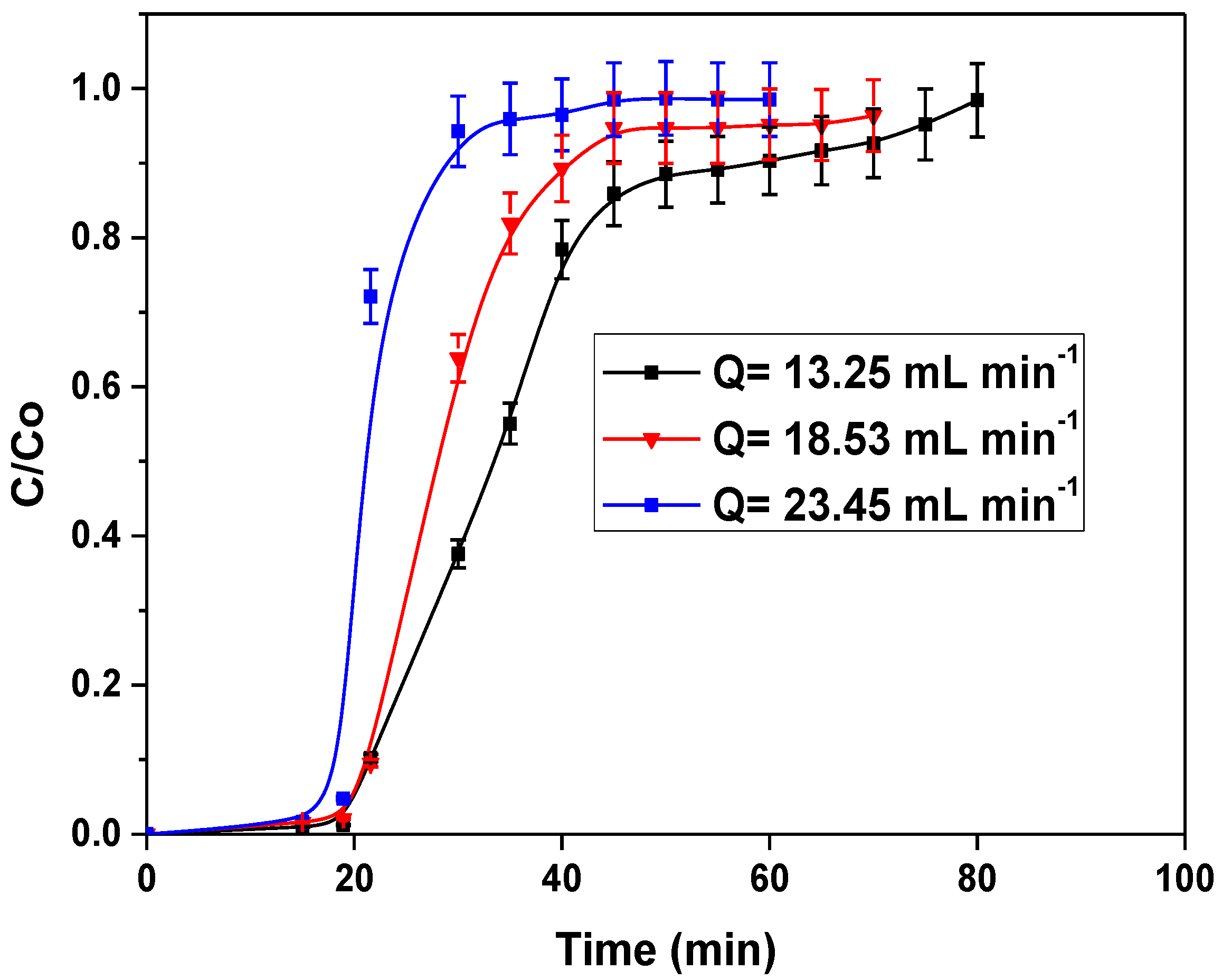

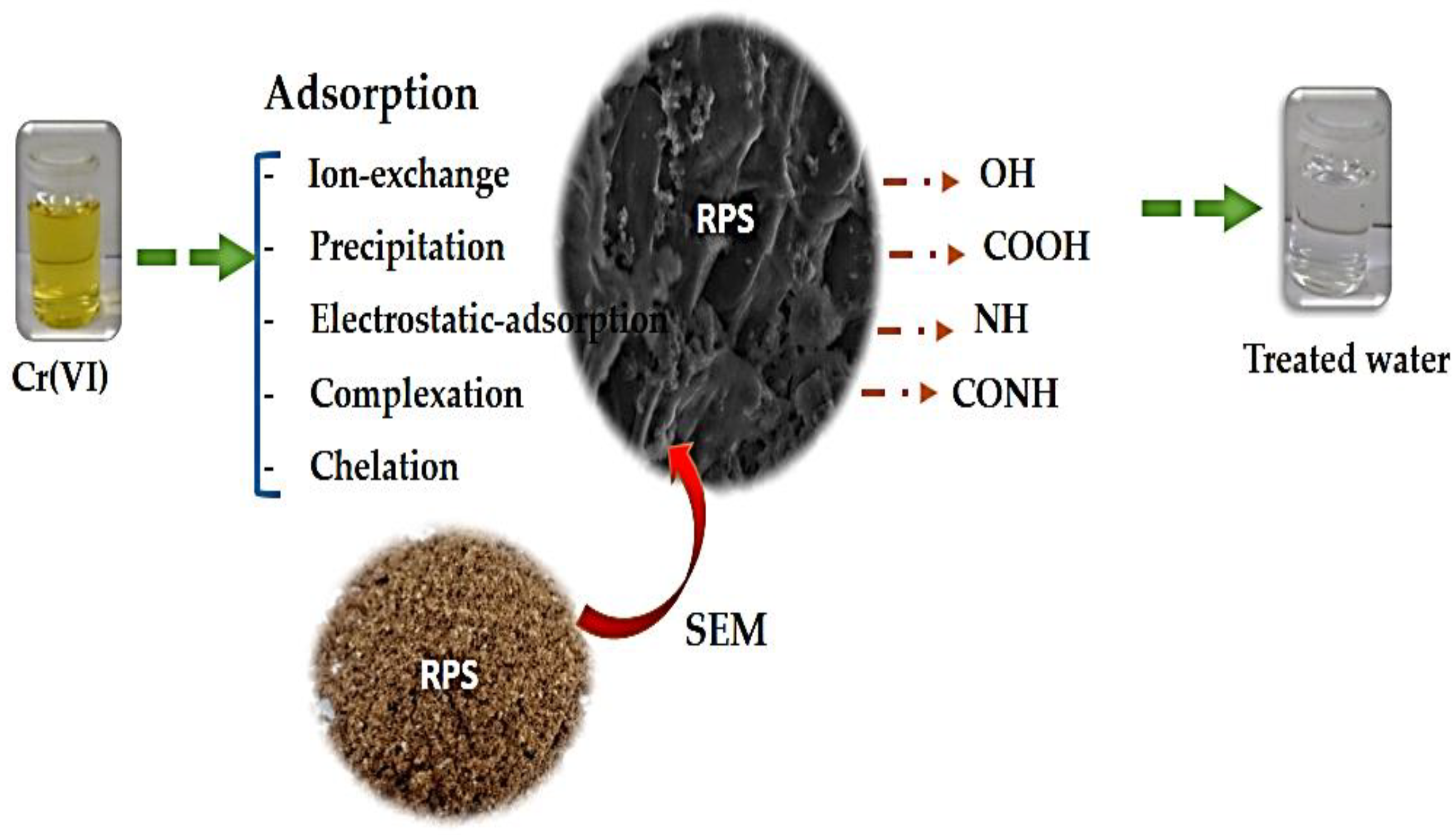
| Element | Raw RPS (% Mass) | Adsorbed Cr(VI) (% Mass) |
|---|---|---|
| C | 98.10 | 90.51 |
| Na | 0.04 | 0.04 |
| Mg | 0.35 | 0.28 |
| Al | 0.04 | 0.04 |
| Si | 0.06 | 0.06 |
| P | 0.13 | 0.12 |
| S | 0.17 | 0.16 |
| Cl | 0.04 | 0.05 |
| K | 0.60 | 3.59 |
| Ca | 0.35 | 0.34 |
| Mn | 0.01 | 0 |
| Fe | 0.02 | 0.02 |
| Ni | 0.0 | 0.01 |
| Cu | 0.01 | 0.01 |
| Zn | 0.06 | 0.05 |
| Rb | 0.01 | 0.01 |
| Sr | 0.01 | 0.01 |
| Pb | 0 | 0.06 |
| Cr | 0 | 4.66 |
| Operating Conditions | Bohart-Adams Model Parameters | |||
|---|---|---|---|---|
| No (m L−1) | KAB (L mg−1min−1) | R2 | ||
| Concentration (mg L−1) | 100 | 2163.98 | 0.0016 | 0.785 |
| 200 | 3865.08 | 0.0006 | 0.983 | |
| 300 | 4932.2 3 | 0.0004 | 0.988 | |
| 400 | 4432.11 | 0.0003 | 0.905 | |
| Flow rate (mL min−1) | 13.25 | 4693.46 | 0.0006 | 0.970 |
| 18.53 | 5416.24 | 0.0008 | 0.952 | |
| 23.35 | 5353.35 | 0.0028 | 0.956 | |
| Bed height (cm) | 10 | 2610.58 | 0.0017 | 0.957 |
| 15 | 1940.37 | 0.0012 | 0.946 | |
| 20 | 2514.30 | 0.0010 | 0.911 | |
| Materials | Adsorption Capacity (mg g−1) | pH | References |
|---|---|---|---|
| Jute fiber (PANI-Jute) | 4.66 | 3 | [9] |
| Acid modified waste activated carbons | 288.19 | 3 | [10] |
| Cetyl tri methyl ammonium bromide | 0.366 | 1.15–1.39 | [12] |
| Olive oil industry waste | 3.33 | 1–2 | [13] |
| Chitosan Fe° Nanoparticles | 32 | 6 | [14] |
| Synthesized chitosan Resin | 100.9 | 3.5 | [15] |
| Chitosan-bond FeC nanoparticules | 10.5 | 7.5 | [16] |
| Xanthated chitosan | 202.25 | 3 | [17] |
| RPS | 26.21 | 5.35 | This work |
Disclaimer/Publisher’s Note: The statements, opinions and data contained in all publications are solely those of the individual author(s) and contributor(s) and not of MDPI and/or the editor(s). MDPI and/or the editor(s) disclaim responsibility for any injury to people or property resulting from any ideas, methods, instructions or products referred to in the content. |
© 2023 by the authors. Licensee MDPI, Basel, Switzerland. This article is an open access article distributed under the terms and conditions of the Creative Commons Attribution (CC BY) license (https://creativecommons.org/licenses/by/4.0/).
Share and Cite
Kebir, M.; Tahraoui, H.; Chabani, M.; Trari, M.; Noureddine, N.; Assadi, A.A.; Amrane, A.; Ben Hamadi, N.; Khezami, L. Water Cleaning by a Continuous Fixed-Bed Column for Cr(VI) Eco-Adsorption with Green Adsorbent-Based Biomass: An Experimental Modeling Study. Processes 2023, 11, 363. https://doi.org/10.3390/pr11020363
Kebir M, Tahraoui H, Chabani M, Trari M, Noureddine N, Assadi AA, Amrane A, Ben Hamadi N, Khezami L. Water Cleaning by a Continuous Fixed-Bed Column for Cr(VI) Eco-Adsorption with Green Adsorbent-Based Biomass: An Experimental Modeling Study. Processes. 2023; 11(2):363. https://doi.org/10.3390/pr11020363
Chicago/Turabian StyleKebir, Mohammed, Hichem Tahraoui, Malika Chabani, Mohamed Trari, Nasrallah Noureddine, Aymen Amin Assadi, Abdeltif Amrane, Naoufel Ben Hamadi, and Lotfi Khezami. 2023. "Water Cleaning by a Continuous Fixed-Bed Column for Cr(VI) Eco-Adsorption with Green Adsorbent-Based Biomass: An Experimental Modeling Study" Processes 11, no. 2: 363. https://doi.org/10.3390/pr11020363
APA StyleKebir, M., Tahraoui, H., Chabani, M., Trari, M., Noureddine, N., Assadi, A. A., Amrane, A., Ben Hamadi, N., & Khezami, L. (2023). Water Cleaning by a Continuous Fixed-Bed Column for Cr(VI) Eco-Adsorption with Green Adsorbent-Based Biomass: An Experimental Modeling Study. Processes, 11(2), 363. https://doi.org/10.3390/pr11020363









